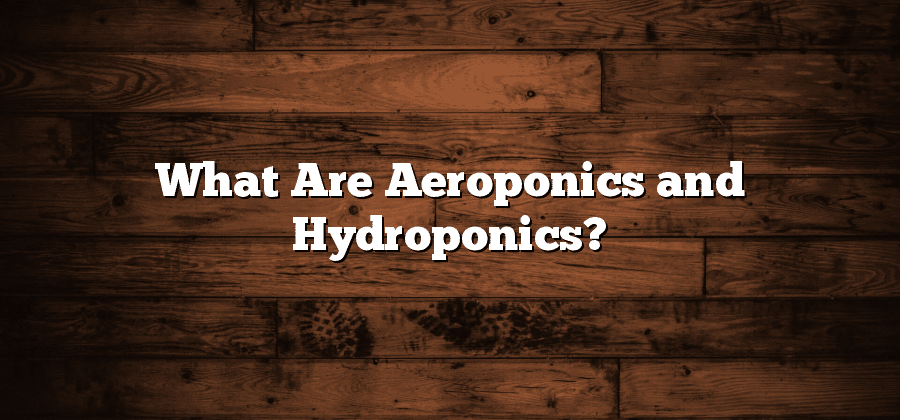Advantages of Aeroponics over Traditional Farming Methods
Aeroponics, a cutting-edge farming method, offers several advantages over traditional farming methods. Firstly, aeroponics requires significantly less water compared to conventional farming. With aeroponics, plants are grown in a highly oxygenated mist environment, eliminating the need for excessive water usage. This water-saving feature not only conserves a precious resource but also reduces the overall environmental impact associated with irrigation.
Secondly, aeroponics allows for faster growth and higher yields. In this technique, plant roots are suspended in the air and constantly misted with a nutrient-rich solution. This direct exposure to nutrients and oxygen accelerates plant growth, resulting in shorter cultivation periods. Moreover, since the roots are not constrained by soil, they can easily access essential nutrients, enabling plants to achieve their full growth potential. As a result, aeroponics boasts higher crop yields per square foot compared to traditional farming methods.
Advantages of Hydroponics over Traditional Farming Methods
Hydroponics, a modern method of farming, offers several advantages over traditional farming methods. Firstly, it allows for precise control over nutrient levels and pH balance, ensuring that plants receive the optimal nutrition they need to grow. Unlike traditional farming, where plants rely on soil nutrients that may be insufficient or imbalanced, hydroponics enables growers to tailor nutrient solutions to the specific needs of each crop. This ensures healthier plants with increased yields and improved quality.
Secondly, hydroponics minimizes water usage compared to traditional farming. In hydroponic systems, water is recycled and used more efficiently, resulting in significant water savings. The controlled environment also reduces water loss through evaporation, further contributing to the conservation of this precious resource. This advantage, coupled with the ability to grow crops vertically in hydroponics, makes it a particularly attractive method for urban farming, where space and resources are often limited.
Differences between Aeroponics and Hydroponics
Aeroponics and hydroponics are both modern farming methods that offer numerous advantages over traditional soil-based farming. However, they differ in several key aspects. Firstly, the primary difference lies in the way the plants are grown. In aeroponics, plants are suspended in air or misted with nutrient-rich solution, allowing the roots to absorb nutrients and oxygen directly. On the other hand, hydroponics involves growing plants in a nutrient-rich solution with their roots submerged in the liquid medium. This distinction in the basic setup contributes to various dissimilarities between the two methods.
Secondly, the type of growth medium used is another significant contrast. While hydroponics relies on materials such as rockwool, perlite, or coconut coir to support the plants and retain moisture, aeroponics eliminates the need for a solid substrate entirely. Instead, it employs a fine mist or fog to deliver nutrients directly to the plant roots. This absence of a physical medium in aeroponics not only enhances nutrient absorption but also eliminates the risk of substrate-borne diseases, making it a more hygienic and efficient cultivation method.
Key Components of an Aeroponic System
Aeroponics, a modern and innovative farming technique, involves growing plants in air without the use of soil or traditional hydroponic mediums. The key components of an aeroponic system include a reservoir tank, a pump, and misting nozzles. The reservoir tank is where the nutrient-rich water is stored, providing the plants with essential minerals. The pump is responsible for delivering the water to the misting nozzles, which in turn spray the water onto the plant roots suspended in the air. The misting nozzles ensure a fine and consistent mist, allowing for optimal nutrient absorption by the plants.
Another crucial component of an aeroponic system is the root chamber, which houses the plant roots and provides support. The root chamber can be constructed using various materials, such as plastic or mesh, allowing for proper root growth and development. Additionally, a timer is typically included in the system to regulate the frequency and duration of misting cycles. This helps ensure that the plants receive an adequate supply of water and nutrients while preventing waterlogging and promoting optimal growth. Overall, these key components work together to create an efficient and effective aeroponic system, promoting healthy plant growth and maximizing yield potential.
Key Components of a Hydroponic System
The Hydroponic system consists of several key components that work together to create a controlled environment for plants to thrive. The first component is the reservoir, which holds the nutrient solution that will be used to feed the plants. This reservoir is typically made of plastic or other durable materials and is designed to hold a specific amount of liquid.
The second component is the pump, which is responsible for circulating the nutrient solution throughout the system. The pump is connected to a series of tubes or pipes that deliver the solution to each plant site. This ensures that each plant receives the necessary nutrients and water for optimal growth.
Another important component of a hydroponic system is the growing medium. Unlike traditional soil-based farming methods, hydroponics uses a neutral medium such as clay pellets, coconut coir, or perlite to support the plants. This medium provides stability for the plants’ roots, allowing them to access oxygen and nutrients more efficiently.
In addition to these key components, a hydroponic system may also include other equipment such as timers, sensors, and grow lights. Timers are used to automatically control the lighting and watering cycles, ensuring that plants receive the right amount of light and nutrients at the appropriate times. Sensors monitor the temperature, humidity, and pH levels, providing valuable data for adjusting the system’s conditions. Lastly, grow lights are used to provide the necessary light spectrum for plant growth, especially in situations where natural sunlight may be limited.
Overall, the key components of a hydroponic system work together to create an efficient and controlled environment for plant cultivation. By providing the right amount of nutrients and water, along with maintaining optimal growing conditions, hydroponics offers the potential for higher yields and faster growth compared to traditional farming methods.






